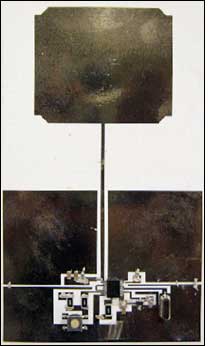A group of scientists at the Georgia Institute of Technology has created a thin medical patch containing an ultrahigh-frequency (UHF) active RFID tag and a sensor designed primarily to monitor the health and whereabouts of its patients. The researchers, working at the Georgia Electronic Design Center (GEDC), launched the project in 2007, and are now talking with health-care organizations and medical device companies to create commercial applications for the patch.
The patch is known as the Prototype of the Integrated RFID-enabled Agile Sensor Lab (PIREAS)—and the Greek city of Pireas also happens to be the hometown of Emmanouil Tentzeris, a professor and leader of the GEDC’s RFID activities. The tag’s antenna, circuit traces and connecting pads are printed on an organic substrate using silver inkjet technology. The tag’s other parts—the IC, temperature sensor, battery and oscillator—are connected to the substrate using silver epoxy.

Because the tag is so thin and flexible, it can be affixed to a patient with an adhesive backing, or sewn into a hospital gown. The researchers did not employ plastic-type substrates because plastic would not be comfortable enough for wearable electronics; instead, they used organic fiber. “This is one thing that makes our research different,” says Li Yang, a GEDC graduate research assistant working on the project. “We’ve made this on an organic substrate, which is basically a fabric-based substrate, and we’ve used conductive ink. That means this tag can be made into clothing, it can be bent, it could be a small Band-Aid. It is very low-profile.” The substrate, Yang adds, has a hydrophobic (water-repelling) layer coating the surface. “Otherwise,” he says, “fiber will absorb a lot of conductive ink and increase the material cost.”
The most recent version of the patch has only a temperature sensor, and would need to be affixed as an adhesive bandage. But the group is considering other sensors as well, including one that works with electrocardiograph (ECG) sensors that measure the heart’s electrical pulses. The active RFID patch could be sewn into a gown and connected to the ECG sensors on the patient’s skin with leads, then wirelessly transmit data from the ECG sensors.
The active RFID tag utilizes a proprietary communications protocol to transmit a 904 MHz signal encoded with its unique ID number and temperature data. The signal can be received and forwarded by other patches, hopping from one to the next, until it is received by an RFID reader.“The hopping extends the range,” Yang explains. The patch is designed to hop the information to any nearby tags. The number of patches through which hopping can occur is unlimited, though the researches have thus far tested hopping only in up to four patches. Without hopping, he says, one patch has a read range of 50 to 200 feet, depending on the environment’s complexity.
Readers can be hung on a wall or embedded in a ceiling, Yang says, and be connected directly to the Internet. The system uses triangulation to pinpoint a patch’s location to within a radius of 10 meters (33 feet). Employing Web-based software developed by the researchers, a computer can display a patch’s location via Google Earth.
The patch is powered by a thin-film battery. Initially, Yang says, the team tested the patch using a 3-volt Lithium-ion coin cell, but the thin-film batteries have a lower profile and are easier to integrate. At present, he notes, a patch’s battery will last for only about one or two months because the RFID tag is designed to automatically emit its ID and temperature data periodically, every few minutes. In order to increase the battery life, however, the team is working to develop a reader that can awaken a dormant RFID tag at defined intervals, then direct that tag to transmit the information. “This would reduce a lot of data redundancy,” Yang says, “and extend the life of the battery, possibly up to a year.”
To protect any intellectual property (IP) related to the patch, the research team has submitted an “invention disclosure” to the Georgia Tech Research Corp.‘s Office of Technology Licensing, which works to protect Georgia Tech’s IP and ensure that those involved in the innovation process remain in compliance with IRS rules, as well as with regulations involving such issues as export controls and conflicts of interest. The Office of Technology Licensing also manages the licensing of technologies and any royalties that may be produced by such a license.
According to Yang, the team has already met with several companies—which he is not at liberty to name at this time—that have expressed interest in partnering to develop commercial applications. One firm, in fact, is interested in working with the researchers to create a patch that operates with ECG sensors.

